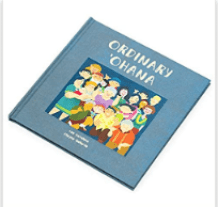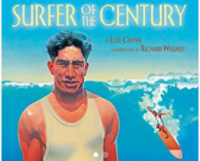So many children’s books about Hawai‘i simply tell readers what they expect to hear, confirming general impressions they already have. But Hawai‘i is a unique and diverse place, and it’s rich in stories and storytellers. In these islands, people from many traditions grow up hearing and sharing each others’ experiences and stories. Here are some of those real stories of Hawai’i for middle-grade readers to enjoy.
I’ll begin with a book about Hawaii’s all-time superhero, Duke Kahanamoku. SURFER OF THE CENTURY by Ellie Crowe tells the story of this legendary three-time winner of Olympic Gold. Although he was considered the fastest swimmer in the world, he also became known as the father of modern surfing, his true passion. It was “The Duke” who introduced the ancient Hawaiian sport to Australia and to the west and east coasts of the U.S. Despite his outstanding skills and accomplishments, Duke Kahanamoku had to deal with serious racial discrimination wherever he went. He responded to these challenges, too, with heroic humor, grace, and patience. Thus he became an example of character and aloha in Hawai‘i and the world. 
SAKAMOTO’S SWIM CLUB: How a Teacher Led and Unlikely Team to Victory by Julie Abery and Chris Sasaki.
THE THREE YEAR SWIM CLUB: The Untold Story of Maui’s Sugar Ditch Kids and Their Quest by Julie Checkoway.
These two books tell a much less well known but equally inspiring story of Olympic swimming heroes from Hawai‘i. An elementary science teacher in rural Maui in the 1930s saw his students playing in the sugar plantation‘s irrigation ditch one day and decided to organize them into a swim team. Soichi Sakamoto was not a coach or even swimmer himself. But he made a scientific study of the techniques and training methods of the world’s best swimmers The club’s dream was to participate in the 1940 Olympics.
They still had to train in the irrigation ditch. There were many excellent swimming pools and facilities in Hawaii, but in those days, only Caucasians were allowed to use them. Duke Kahanamoku’s example of aloha inspired the team to overcome the racial barriers and bigotry they encountered at home and across the country.Soon they began winning every meet they entered, and took the national title. They were even set to fill most of the slots on the U.S. Olympic Team in 1940, realizing their dream.
Then the outbreak of World War II cancelled that event. At the 1948 Olympics, the first held in 12 years, the team’s goal finally became a reality. The star of that event was captain of the US swim team, native Hawaiian Bill Smith Jr., who had trained with Mr. Sakamoto. He was first of many boys and girls from the club to distinguish themselves in the sport and in other leadership roles.
The Many Stories of Graham Salisbury
Graham Salisbury has mined his “magical” childhood growing up on O‘ahu and Hawai‘i islands to become one of Hawai‘i’s most engaging storytellers.  Readers on the younger side
Readers on the younger side of middle grade will enjoy sharing the adventures and humorous predicaments of delightfully clueless Calvin Coconut. This series is based on Salisbury’s own elementary years on the windward side of O‘ahu.
of middle grade will enjoy sharing the adventures and humorous predicaments of delightfully clueless Calvin Coconut. This series is based on Salisbury’s own elementary years on the windward side of O‘ahu. 
 For older readers, there are BLUE SKIN OF THE SEA and ISLAND BOYZ, collections of short stories about growing up in Hawai‘i and the things that experience teaches you.
For older readers, there are BLUE SKIN OF THE SEA and ISLAND BOYZ, collections of short stories about growing up in Hawai‘i and the things that experience teaches you.
But Salisbury is best known for his novels. The most famous, UNDER THE BLOOD-RED SUN, draws on the World War II experiences of his father’s family. The story centers on the challenges faced by two best friends in Kona— Tomi, a Japanese-American boy and Billy, a Caucasian–  When the Japanese attack Pearl Harbor. Suddenly the Japanese are the enemy. This is the first of several award-winning novels in his Prisoners of Empire series, focusing on the World War II experiences of Japanese-Americans from Hawai‘i. The veterans he has interviewed for these stories have thanked him for telling their story by making him an honorary member of the famous 442nd “Go For Broke” regiment.
When the Japanese attack Pearl Harbor. Suddenly the Japanese are the enemy. This is the first of several award-winning novels in his Prisoners of Empire series, focusing on the World War II experiences of Japanese-Americans from Hawai‘i. The veterans he has interviewed for these stories have thanked him for telling their story by making him an honorary member of the famous 442nd “Go For Broke” regiment.
Salisbury has published 20 books set in Hawai‘i. In any of them , you can count on great writing, compelling characters, suspense, and surprising, humorous turns.
Hawai‘i Fantasy
Real stories can be told not just in nonfiction accounts and in realistic fiction, such as Salisbury’s, but also in fantasy and magical realism. Unless fantasy is based in a believable, knowable world, it won’t engage readers. Hawai‘i, with all its myths and legends, was long overdue for some good middle grade fantasy that rings true. Then Lehua Parker delivered with her page-turning ONE BOY, NO WATER. In this first book of the Niuhi Shark Saga,  Zadar is found on the reef as a baby. A family of surfers and fishermen adopts him. Yet the boy is mysteriously allergic to water. Who is he really, and where did he come from? Someone must know, but they’re certainly not telling Zader. And he keeps having such frightening dreams.
Zadar is found on the reef as a baby. A family of surfers and fishermen adopts him. Yet the boy is mysteriously allergic to water. Who is he really, and where did he come from? Someone must know, but they’re certainly not telling Zader. And he keeps having such frightening dreams.
“Auntie” Lehua Parker is thoroughly familiar both with Hawaiian myths and legends and with daily life and relationships in the islands. So she is able to weave the extraordinary and supernatural into an ordinary contemporary scene in ways that are sometimes startling and often humorous. Her characters are flawed, amusing, down-home, and unforgettable. As is her storytelling. Who is Zadar? You may have to read the whole trilogy to find out.
Some Illustrated Stories
The last three stories I recommend are told in picture books. The language and information level of these books, and particularly their themes, make them age-suitable for middle grade readers.
SNOW ANGEL, SAND ANGEL,
By Lois Ann Yamanaka and Ashley Lukashevsky
What does it mean to say that Hawaii is a special place? Like many children growing up in the islands, Claire wishes she could see a winter wonderland of snow. Her dad takes her to the top of Mauna Kea where there is plenty of the stuff. But it is not like she imagined. This is crusty old snow she can’t make anything out of. Later they go to the beach where they build a “snowman” out of sand and make sand angels. Claire begins to see that she can enjoy her own kind of winter surrounded by the sand, ocean and the beautiful mountains of her island. Back matter features the flora and fauna of the islands and shows the importance of the environment in Hawaiian culture.
HO‘ONANI: HULA WARRIOR
by Heather Gale and Mika Song
Ancient Hawaiians recognized and respected a third gender. They called it mahu (“in the middle”). Hawaiians believed that the mahu had spritual powers and a special role to play in the culture, But in modern times mahu has become a term of ridicule for gays, lesbians, and transgender people, HO‘ONANI, HULA WARRIOR, is based on the true story of a girl in a Hawaiian immersion school who saw herself as both boy and girl. Ho‘onani wants to perform a male-style hula chant at a school event. This meets with disapproval and resistance. Drawing strngth from the old ways, she persists. Ho‘onani becomes a strong leader who learns to accept herself and inspires others to be inclusive.
ORDINARY OHANA
by Lee Cataluna and Cheyne Gallarde
The Hawaiian word Ohana means family, but family in a much broader sense than the usual use of that world. Your ohana can include your extended family and also people not related to you. Neighbors, friends, people of all backgrounds, anyone you welcome with mutual love and support can be your ohana. Playwright Lee Cataluna’s warm and humorous all-ages book celebrates this ohana and its underlying spirit of aloha in down-to earth detail.
Aloha, Everyone. I hope readers of these books will enjoy getting to know Hawai‘i where people of many different backgrounds have learned over time to live together with respect and acceptance.


I love the history and language of Hawaii! It’s so culturally rich. I was stationed at Pearl Harbor in the 1980s and just moved my son there last summer to Honolulu. Duke is legendary! Will be back there next month to eat at “Duke’s”. 🙂 Wonderful to see this list of books curated for kids to discover more of Hawaii.
Thanks,Donna. Legendary, yes indeed. I’ve lived here all my adult life and actually sat near Duke Kahanamoku once at a coffee shop where he tried, unsuccessfully, to order a salad with iceberg lettuce. I later wrote a poem about that called “I’d Have Found That Iceberg” in which I imagined being that waitress ;). Duke Kahanamoku set an example, not only of excellence but of humility and character, that still influences surfing champions like John-John Florence and Carissa Moore today. I hope your son has a great time in Hawai‘i.